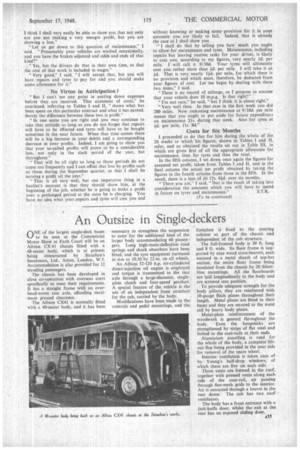An Outsize in Single-deckers
Page 53

If you've noticed an error in this article please click here to report it so we can fix it.
ONE of the largest single-deck buses to be seen at the Commercial Motor Show at Earls Court will be an Albion CX 41 chassis fitted with a 48-seater body, which is at present being constructed by Strachan's Successors, Ltd., Acton, London, W.5. Accommodation is also provided for 12 standing passengers.
The chassis has been developed in close co-operation with overseas users specifically to meet their requirements. It has a straight frame with an overhead-worm rear axle, affording maximum ground clearance.
The Albion CX41 is normally fitted with a 40-seater body, and it has been necessary to strengthen the suspension to cater for the additional load of the larger body accommodating 60 passengers. Long high-static-deflection road springs and shock absorbers have been fitted, and the tyre equipment increased in size to 10.50 by 22-in, on all wheels.
An Albion 52-120 h.p. six-cylindered direct-injection oil engine is employed and torque is transmitted to the rear axle through a large-diameter, singleplate clutch and four-speed gearbox. A special feature of the vehicle is the use of an independent front structure for the cab, carried by the body.
Modifications have been made to the controls and pedal mountings, and the footplate is fixed to the steering column as part of the chassis and independent of the cab structure.
The full-fronted body is 30 ft. long and 8 ft. wide. Its floor frame is supported by nine wood cross-bearers, each encased in a metal sheath of top-hat section, the entire floor frame being insulated from the chassis by 20 Silentbloc mountings. All the floorboards are laid longitudinally in the body and are screwed into position.
To provide adequate strength for the body pillars, they are reinforced with 10-gauge flitch plates throughout their length. Metal plates are fitted to their bases and they are secured to the waist rail by heavy body plates.
Metal-plate reinforcement of the woodwork is general throughout the body. Even the hoopsticks are strengthened by strips of flat steel and bolted to the cant-rails at their ends.
Aluminium panelling is used for the whole of the body, a complete liftout flap being provided in the near side for removal of the spare wheel.
Interior ventilation is taken care of by Young's half-drop windows, of which there are five on each side.
Three vents are formed in the roof, together with pressed vents along each side of the cant-rail, air passing through fine-mesh grids to the interior. Air is extracted through a louvre in the rear dome. The cab has two roof ventilators.
The body has a front entrance with a jack-knife door, whilst the exit at the rear has an exposed sliding door.




















































































